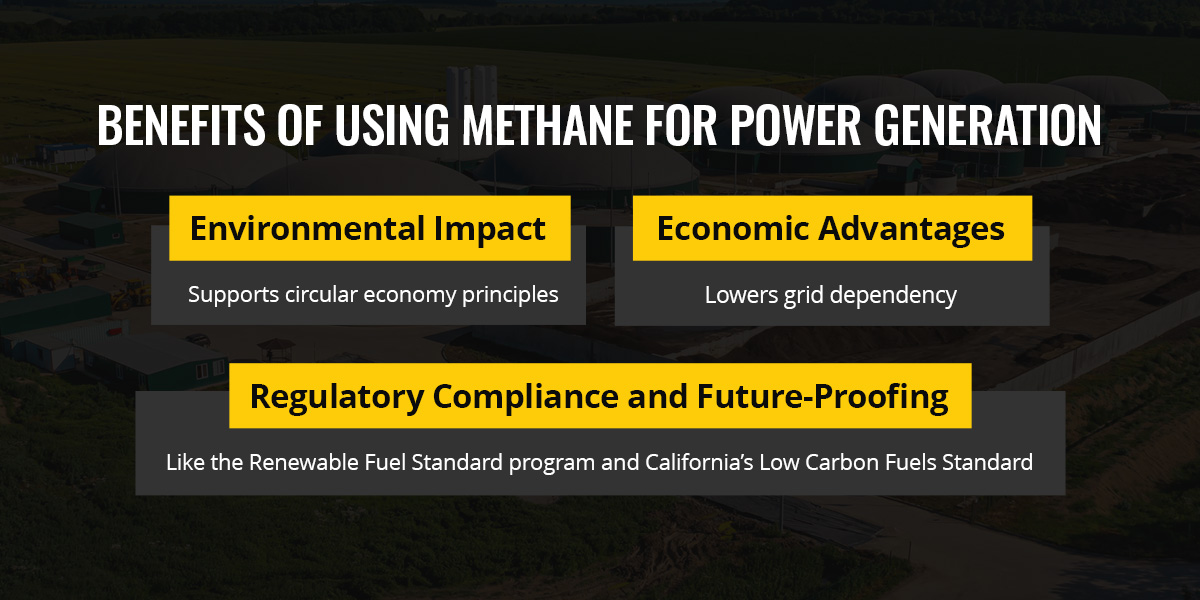
Methane is a powerful, underutilized energy source with significant potential for the construction and industrial sectors. The need for sustainable, reliable, and cost-effective power solutions on jobsites is growing as regulations tighten and sustainability goals become more important.
This guide explores how natural gas is converted into electricity, its benefits, and why it’s relevant for contractors, engineers, and decision-makers seeking to future-proof their operations.
Methane gas is a clean-burning fuel that can be captured from waste at landfills, farms, or wastewater plants. On jobsites, it can power generators, providing reliable electricity while reducing costs and environmental impact.
Methane (CH₄) consists of one carbon atom and four hydrogen atoms. It is a colorless, odorless, and highly combustible gas, the primary component of natural gas.
It is a powerful greenhouse gas, trapping heat in the environment and contributing to climate change. Methane gas combustion is accepted as a more sustainable fuel because it has a shorter atmospheric lifespan than carbon dioxide (CO2) and is much better at trapping heat.
When captured and used as fuel, methane becomes a valuable energy resource. The main sources of methane are:
Methane is abundant and can be harnessed to turn many environmental liabilities into power assets. Annually, the United States produces about:
It’s estimated that 17,000 new biogas projects could be built to produce around 29 gigawatts of electricity 24/7. This would create about a million short-term construction jobs, 45,000 permanent operations jobs, and thousands of indirect supply chain jobs.
Methane gas is often a by-product of construction site activities like wastewater treatment or organic waste decomposition. It can be converted to electricity through various methods. These include combustion in engines or turbines to generate power, or potentially through microbial fuel cells for direct natural gas electricity generation.
Electricity is produced from natural gas using:
The construction and industrial sectors are looking for cleaner, more cost-effective ways to power their operations. Methane gas stands out as a smart solution. Companies are capturing methane from waste or existing sources and converting it into electricity using on-site natural gas electricity generators. This is an efficient way to unlock a range of benefits.

Capturing and using methane reduces greenhouse gas emissions, helping meet regulatory and corporate sustainability targets. Methane-to-electricity projects turn waste into energy, supporting circular economy principles.
Methane is often available at low or negative cost, from waste streams, for example. This reduces fuel expenses. On-site methane-powered electric generators can lower grid dependency and avoid peak electricity charges. These projects can also generate revenue through renewable energy credits or carbon offset programs.
Many regions now require methane capture and utilization to reduce emissions, like the Renewable Fuel Standard (RFS) program and California’s Low Carbon Fuels Standard (LCFS).
Driven by new federal and state-level policy support, the U.S. has accelerated its production of biomethane, aiming to double its supplies by 2026.
Early adoption of methane gas as a power source positions companies as leaders in sustainability and compliance, reducing future regulatory risks.
Methane-powered generators are transforming how construction and industrial teams access reliable electricity. Here’s how these solutions are making a difference on the ground.
Mobile and towable methane-powered electric generators offer flexible power wherever it’s needed most, including:
For projects far from the grid or in urgent situations, methane generators deliver dependable energy in a few ways. These generators can be rapidly deployed and relocated as project needs change. They also offer a reliable alternative to diesel, often with lower emissions and operating costs.
Pairing methane fuel with Cat® generators brings powerful, practical benefits to construction and industrial operations. Here’s what makes this integration stand out.
Cat generators are built for versatility and performance:
Cat equipment delivers the reliability and innovation today’s projects need, including:
Proper care and smart monitoring keep methane-powered Cat generators running at their best. Prioritize regular inspection and cleaning of fuel delivery systems to handle impurities in biogas. Use remote monitoring platforms to optimize uptime and schedule preventive maintenance.
Turn to Thompson Power Systems for expert support regarding installation, troubleshooting, and ongoing service to ensure your generator is ready when you need it.
Thompson Power Systems combines industry-leading Cat equipment with deep expertise in alternative fuel integration. We have decades of experience serving construction, industrial, and emergency power needs. We offer full-service support, from project planning and equipment selection to installation, monitoring, and maintenance.
Ready to power your next project with reliable, sustainable energy? Our experts will help you design a solution that meets your operational, regulatory, and sustainability goals.
Contact us today for a consultation or quote on methane-compatible Cat generators.